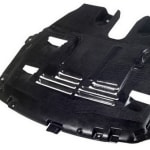 Increasing numbers of automotive manufacturers are using Tepex continuous-fiber-reinforced thermoplastic composite semi-finished products from Lanxess for the lightweight design of parts in large series production. An emerging application for the composite is the door module carrier for a compact-class vehicle from an international automotive manufacturer. Lanxess recently received a contract from German system supplier Brose Fahrzeugteile GmbH & Co. KG to supply the carrier's manufacturer, ElringKlinger AG, with the composite material. "The structural component exemplifies the tremendous potential opened up by our composite in cost-effective lightweight design. With our know-how in materials, virtual component design and simulation of the manufacturing process, we've made a key contribution to this successful development," says Henrik Plaggenborg, Head of the Technical Marketing & Business Development Tepex Automotive group. Lanxess subsidiary Bond-Laminates, which develops and manufactures Tepex, will be supplying ElringKlinger in Europe with the Tepex composite sheet.
Increasing numbers of automotive manufacturers are using Tepex continuous-fiber-reinforced thermoplastic composite semi-finished products from Lanxess for the lightweight design of parts in large series production. An emerging application for the composite is the door module carrier for a compact-class vehicle from an international automotive manufacturer. Lanxess recently received a contract from German system supplier Brose Fahrzeugteile GmbH & Co. KG to supply the carrier's manufacturer, ElringKlinger AG, with the composite material. "The structural component exemplifies the tremendous potential opened up by our composite in cost-effective lightweight design. With our know-how in materials, virtual component design and simulation of the manufacturing process, we've made a key contribution to this successful development," says Henrik Plaggenborg, Head of the Technical Marketing & Business Development Tepex Automotive group. Lanxess subsidiary Bond-Laminates, which develops and manufactures Tepex, will be supplying ElringKlinger in Europe with the Tepex composite sheet. The component is the result of a close partnership between Brose, ElringKlinger and Lanxess over a number of years. The weight has been cut by around 1.6 kilograms per vehicle compared with injection-molded component designs. "With four door modules, weight savings of approximately five kilograms per vehicle are possible compared with a steel version," says Plaggenborg.
The door module carrier is produced in a hybrid molding process using forming and back-injection of Tepex directly in the injection mold. "The one-shot process industrialized by ElringKlinger eliminates the forming tool, while also enabling cost-cutting integration of functions. These two things are the key to making the component cost-effective," says Harri Dittmar, project manager in the Technical Marketing and Business Development Group.
Tepex has already established itself in various series applications in structural lightweight automotive design. For example, it is used to produce front-end carriers, bumper beams, infotainment brackets, underfloor protection paneling, brake pedals, battery consoles, seat shells and seat backrests. "By annually supplying blanks in quantities of seven-digit figures for door module carriers, we're once again demonstrating Tepex's suitability for large series production on the market," says Dr. Christian Obermann, Managing Director at Bond-Laminates.



